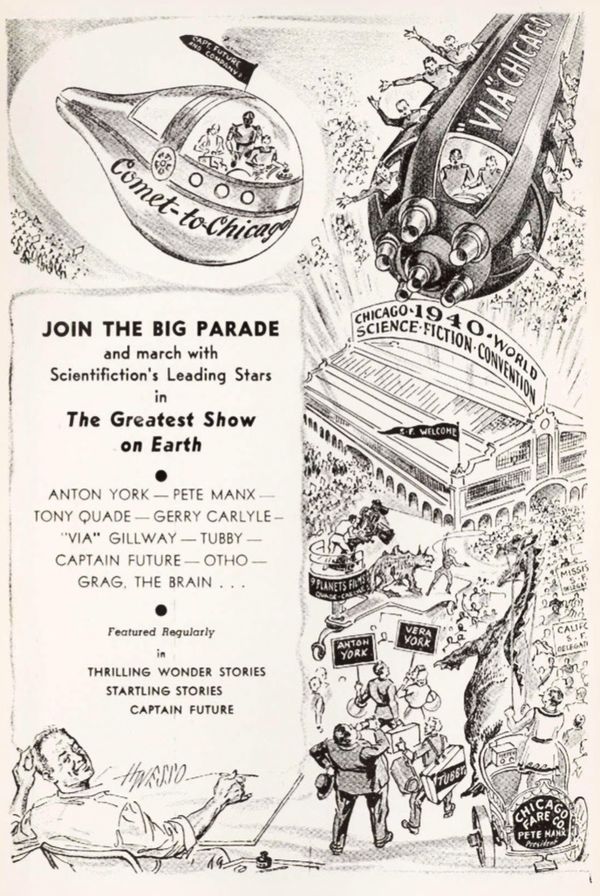Difference between revisions of "Thrilling Wonder Stories"
| (7 intermediate revisions by 2 users not shown) | |||
| Line 1: | Line 1: | ||
| − | '' | + | ''(Were you looking for [[Wonder|a different Wonder]]?) |
| − | |||
| − | With this magazine, Gernsback created the [[Science Fiction League]], the seminal [[sf]] [[club]] that led to the emergence of [[fandom]]. A letter in its August 1939 issue originated the infamous [[catchphrase]] “[[Goshwowoboyoboy]],” quoted by Time magazine. | + | '''''Thrilling Wonder Stories''''' (often abbreviated '''TWS'''), founded by [[Hugo Gernsback]], was one of the earliest [[science fiction magazines]]. |
| + | |||
| + | After losing control of ''[[Amazing Stories]]'', Gernsback launched '''''Air Wonder Stories''''' and '''''Science Wonder Stories''''' in 1929. ''Air Wonder Stories'' (Stellar Publishing Corp) was the first of the so-called "specialist" SF magazines. The editor was [[David Lasser]] (1929–33). Total number of issues published was 11. | ||
| + | |||
| + | Gernsback began popularizing the term ''[[science fiction]]'' in the first issue of ''Science Wonder Stories''. In 1930, he merged the two magazines into ''Wonder Stories''. He sold the [[prozine]] to another [[pulp]] house in 1936, and then it became ''Thrilling Wonder Stories'', which lasted until 1955. | ||
| + | |||
| + | With this magazine, Gernsback created the [[Science Fiction League]], the seminal [[sf]] [[club]] that led to the emergence of [[fandom]]. Its [[lettercolumn]] was “'''The Reader Speaks'''.” A letter in its August 1939 issue originated the infamous [[catchphrase]] “[[Goshwowoboyoboy]],” quoted by Time magazine. | ||
| + | |||
| + | {{SFE|name=tws}}. | ||
| + | |||
| + | |||
| + | [[File:WessoAd.jpeg|thumb|upright=2|center|Ad for ''TWS, [[Startling Stories]]'' and ''[[Captain Future]]'' featuring [[Hans Wesso]] [[art]] from the [[Chicon]] [[program book]], 1940. ]] | ||
| + | |||
{{publication | start=1936 | end=1955}} | {{publication | start=1936 | end=1955}} | ||
[[Category:prozine]] | [[Category:prozine]] | ||
[[Category:US]] | [[Category:US]] | ||
Latest revision as of 14:17, 20 November 2023
(Were you looking for a different Wonder?)
Thrilling Wonder Stories (often abbreviated TWS), founded by Hugo Gernsback, was one of the earliest science fiction magazines.
After losing control of Amazing Stories, Gernsback launched Air Wonder Stories and Science Wonder Stories in 1929. Air Wonder Stories (Stellar Publishing Corp) was the first of the so-called "specialist" SF magazines. The editor was David Lasser (1929–33). Total number of issues published was 11.
Gernsback began popularizing the term science fiction in the first issue of Science Wonder Stories. In 1930, he merged the two magazines into Wonder Stories. He sold the prozine to another pulp house in 1936, and then it became Thrilling Wonder Stories, which lasted until 1955.
With this magazine, Gernsback created the Science Fiction League, the seminal sf club that led to the emergence of fandom. Its lettercolumn was “The Reader Speaks.” A letter in its August 1939 issue originated the infamous catchphrase “Goshwowoboyoboy,” quoted by Time magazine.
Entry in The Encyclopedia of Science Fiction.

| Publication | 1936—1955 |
| This is a publication page. Please extend it by adding information about when and by whom it was published, how many issues it has had, (including adding a partial or complete checklist), its contents (including perhaps a ToC listing), its size and repro method, regular columnists, its impact on fandom, or by adding scans or links to scans. See Standards for Publications. |